University of Greenwich: Racism, Business Management Essay (BUSI 1475)
VerifiedAdded on 2021/08/20
|21
|4588
|312
Essay
AI Summary
This essay, prepared for a Business Management course at the University of Greenwich, delves into the multifaceted issue of racism, particularly focusing on its relevance to globalization, technology, and conflict-collaboration dynamics. The introduction highlights the persistence of racism in the United States, despite societal progress, using historical examples and current events, such as anti-Asian sentiment during the COVID-19 pandemic. The essay then explores how globalization, with its interconnectedness and multiculturalism, both reflects and exacerbates racial tensions. It examines the role of technology, especially social media, in both amplifying and potentially mitigating racist sentiments. The analysis also covers conflict and collaboration, underscoring how racism fuels conflict while also exploring avenues for collaboration to combat discrimination. The essay incorporates data from the Anti-Defamation League (ADL) and other sources to illustrate the impact of racism, including its effects on mental health, economic outcomes, and social interactions. The conclusion synthesizes these themes and offers a personal perspective on the issue, emphasizing the need for continued efforts to address racism in various contexts.
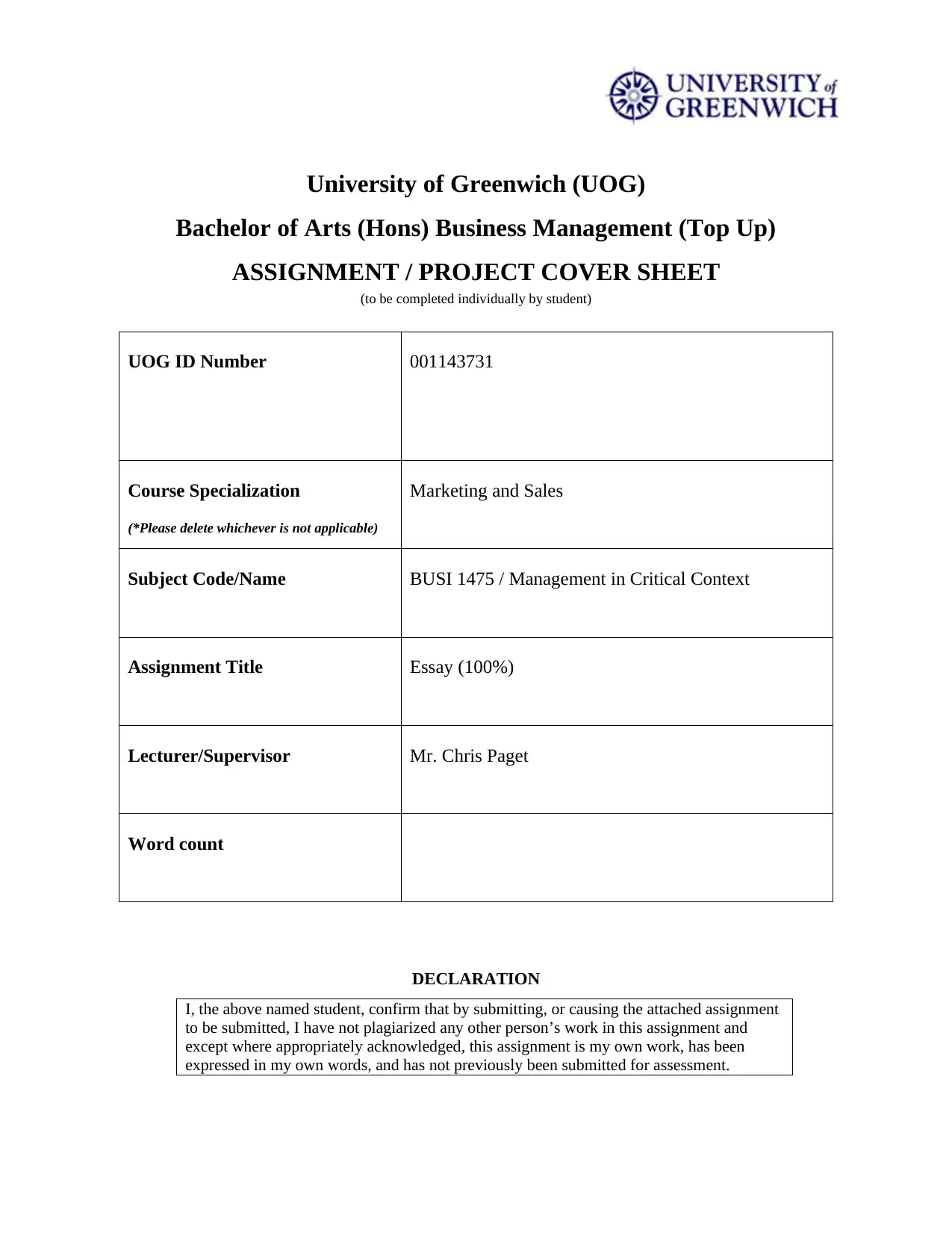
University of Greenwich (UOG)
Bachelor of Arts (Hons) Business Management (Top Up)
ASSIGNMENT / PROJECT COVER SHEET
(to be completed individually by student)
UOG ID Number 001143731
Course Specialization
(*Please delete whichever is not applicable)
Marketing and Sales
Subject Code/Name BUSI 1475 / Management in Critical Context
Assignment Title Essay (100%)
Lecturer/Supervisor Mr. Chris Paget
Word count
DECLARATION
I, the above named student, confirm that by submitting, or causing the attached assignment
to be submitted, I have not plagiarized any other person’s work in this assignment and
except where appropriately acknowledged, this assignment is my own work, has been
expressed in my own words, and has not previously been submitted for assessment.
Bachelor of Arts (Hons) Business Management (Top Up)
ASSIGNMENT / PROJECT COVER SHEET
(to be completed individually by student)
UOG ID Number 001143731
Course Specialization
(*Please delete whichever is not applicable)
Marketing and Sales
Subject Code/Name BUSI 1475 / Management in Critical Context
Assignment Title Essay (100%)
Lecturer/Supervisor Mr. Chris Paget
Word count
DECLARATION
I, the above named student, confirm that by submitting, or causing the attached assignment
to be submitted, I have not plagiarized any other person’s work in this assignment and
except where appropriately acknowledged, this assignment is my own work, has been
expressed in my own words, and has not previously been submitted for assessment.
Paraphrase This Document
Need a fresh take? Get an instant paraphrase of this document with our AI Paraphraser
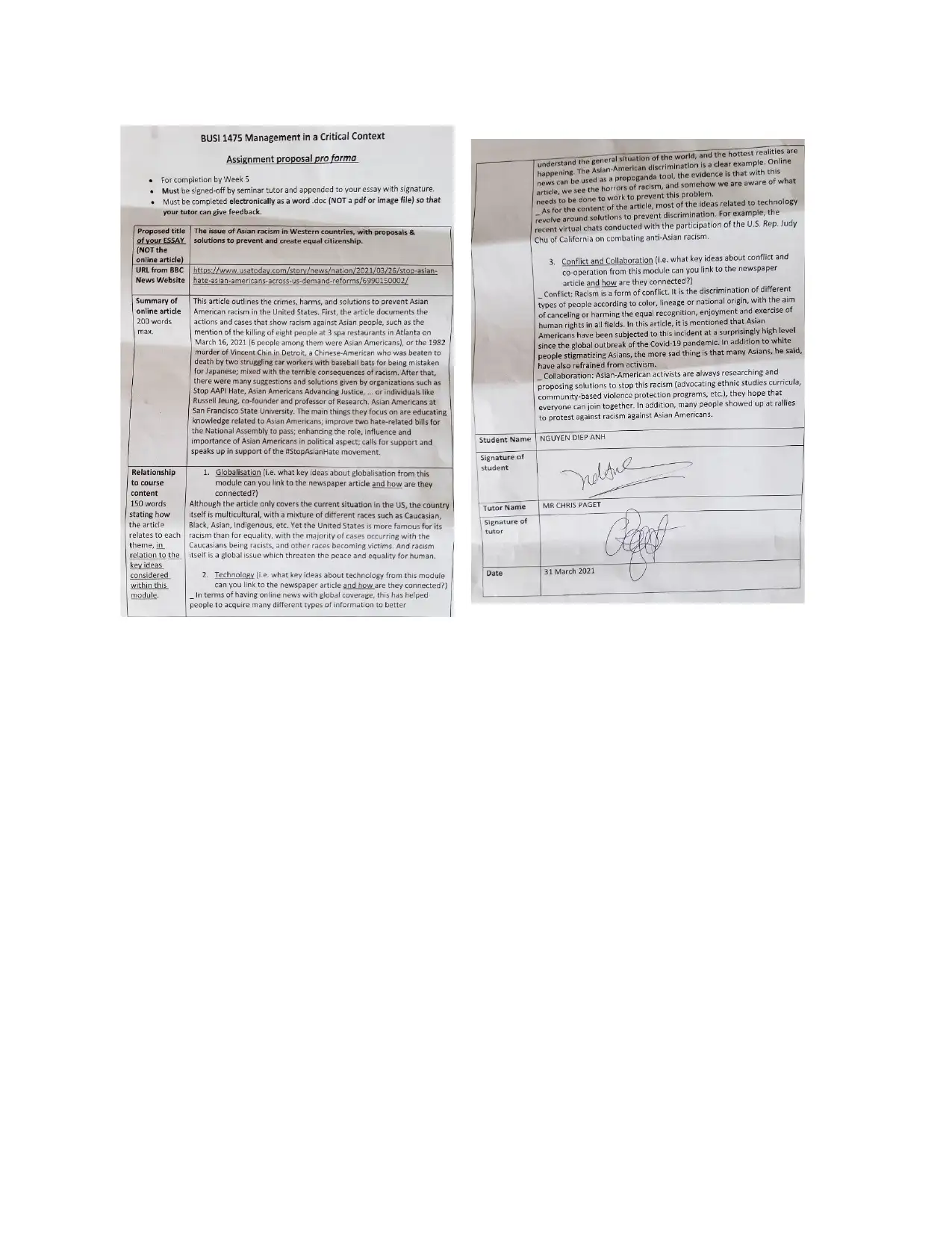
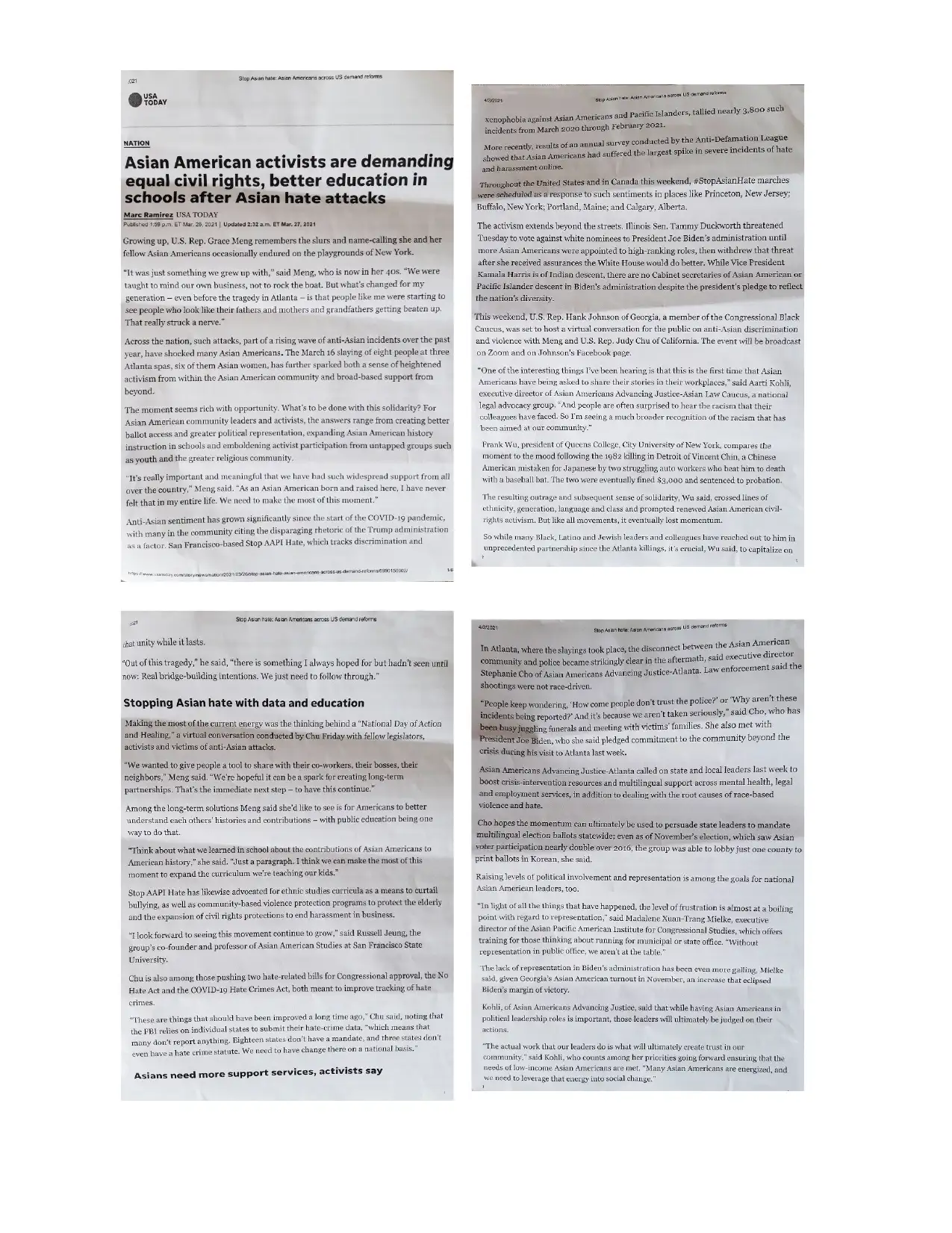
⊘ This is a preview!⊘
Do you want full access?
Subscribe today to unlock all pages.

Trusted by 1+ million students worldwide
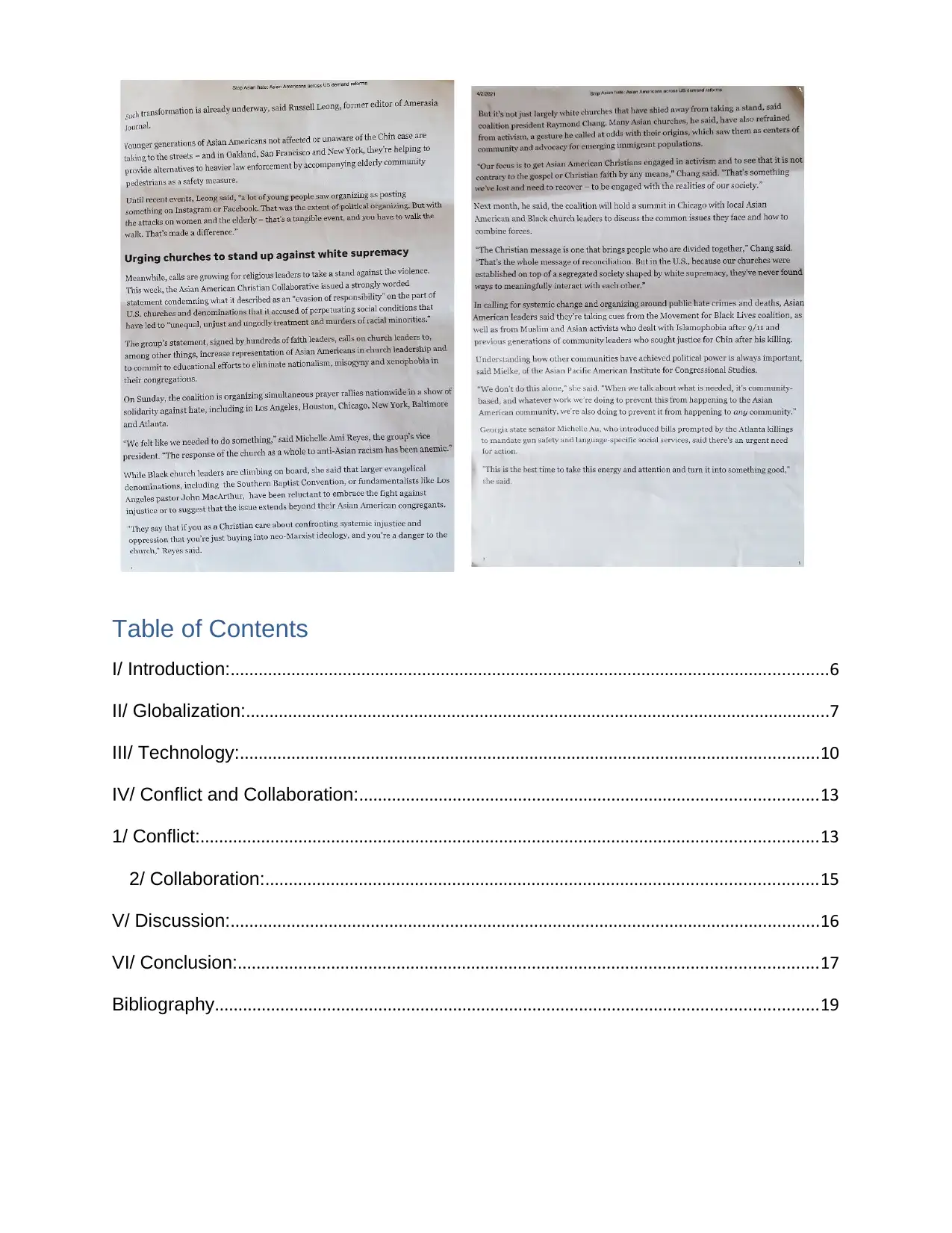
Table of Contents
I/ Introduction:................................................................................................................................6
II/ Globalization:.............................................................................................................................7
III/ Technology:............................................................................................................................10
IV/ Conflict and Collaboration:..................................................................................................13
1/ Conflict:....................................................................................................................................13
2/ Collaboration:......................................................................................................................15
V/ Discussion:..............................................................................................................................16
VI/ Conclusion:............................................................................................................................17
Bibliography.................................................................................................................................19
I/ Introduction:................................................................................................................................6
II/ Globalization:.............................................................................................................................7
III/ Technology:............................................................................................................................10
IV/ Conflict and Collaboration:..................................................................................................13
1/ Conflict:....................................................................................................................................13
2/ Collaboration:......................................................................................................................15
V/ Discussion:..............................................................................................................................16
VI/ Conclusion:............................................................................................................................17
Bibliography.................................................................................................................................19
Paraphrase This Document
Need a fresh take? Get an instant paraphrase of this document with our AI Paraphraser
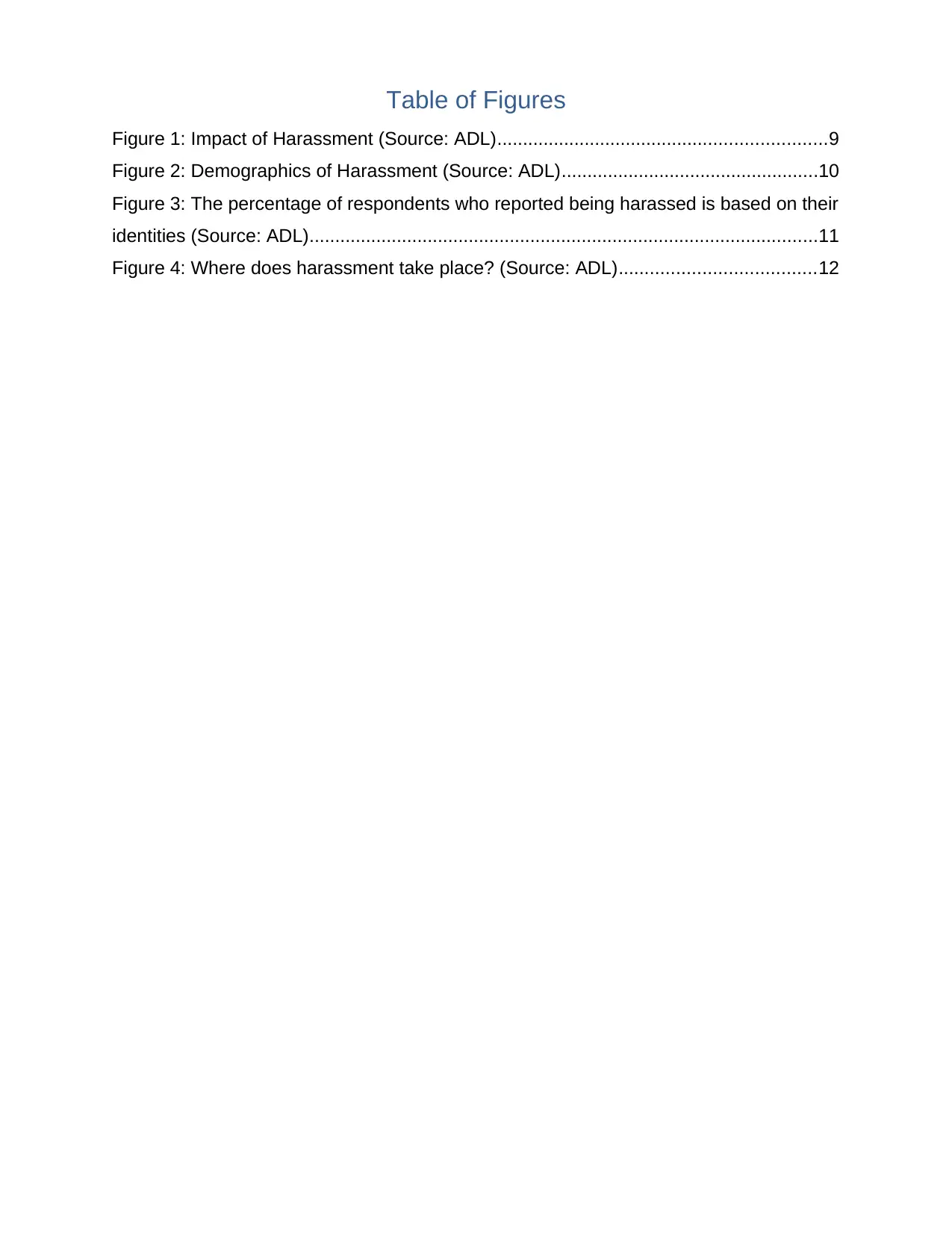
Table of Figures
Figure 1: Impact of Harassment (Source: ADL)................................................................9
Figure 2: Demographics of Harassment (Source: ADL)..................................................10
Figure 3: The percentage of respondents who reported being harassed is based on their
identities (Source: ADL)...................................................................................................11
Figure 4: Where does harassment take place? (Source: ADL)......................................12
Figure 1: Impact of Harassment (Source: ADL)................................................................9
Figure 2: Demographics of Harassment (Source: ADL)..................................................10
Figure 3: The percentage of respondents who reported being harassed is based on their
identities (Source: ADL)...................................................................................................11
Figure 4: Where does harassment take place? (Source: ADL)......................................12
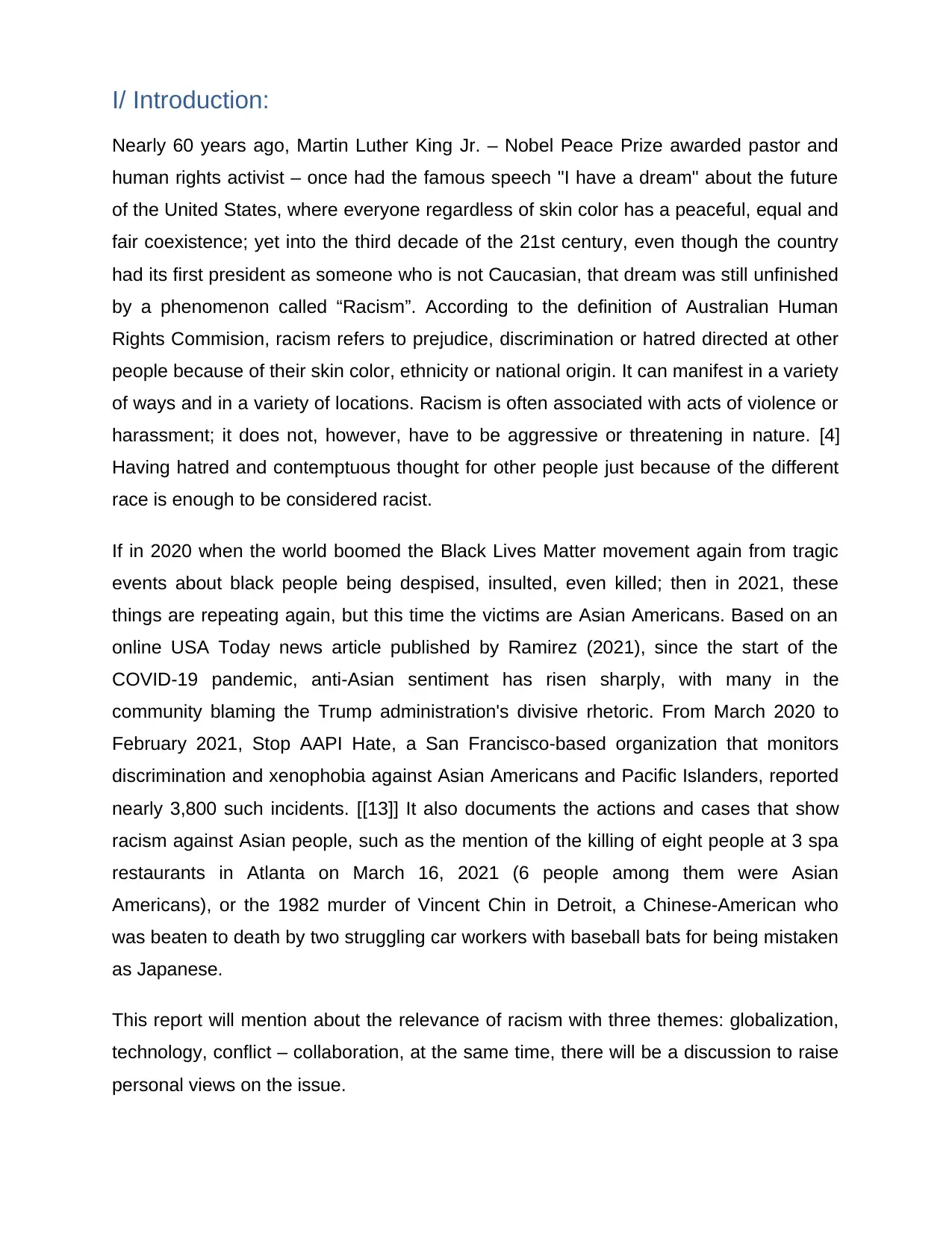
I/ Introduction:
Nearly 60 years ago, Martin Luther King Jr. – Nobel Peace Prize awarded pastor and
human rights activist – once had the famous speech "I have a dream" about the future
of the United States, where everyone regardless of skin color has a peaceful, equal and
fair coexistence; yet into the third decade of the 21st century, even though the country
had its first president as someone who is not Caucasian, that dream was still unfinished
by a phenomenon called “Racism”. According to the definition of Australian Human
Rights Commision, racism refers to prejudice, discrimination or hatred directed at other
people because of their skin color, ethnicity or national origin. It can manifest in a variety
of ways and in a variety of locations. Racism is often associated with acts of violence or
harassment; it does not, however, have to be aggressive or threatening in nature. [4]
Having hatred and contemptuous thought for other people just because of the different
race is enough to be considered racist.
If in 2020 when the world boomed the Black Lives Matter movement again from tragic
events about black people being despised, insulted, even killed; then in 2021, these
things are repeating again, but this time the victims are Asian Americans. Based on an
online USA Today news article published by Ramirez (2021), since the start of the
COVID-19 pandemic, anti-Asian sentiment has risen sharply, with many in the
community blaming the Trump administration's divisive rhetoric. From March 2020 to
February 2021, Stop AAPI Hate, a San Francisco-based organization that monitors
discrimination and xenophobia against Asian Americans and Pacific Islanders, reported
nearly 3,800 such incidents. [[13]] It also documents the actions and cases that show
racism against Asian people, such as the mention of the killing of eight people at 3 spa
restaurants in Atlanta on March 16, 2021 (6 people among them were Asian
Americans), or the 1982 murder of Vincent Chin in Detroit, a Chinese-American who
was beaten to death by two struggling car workers with baseball bats for being mistaken
as Japanese.
This report will mention about the relevance of racism with three themes: globalization,
technology, conflict – collaboration, at the same time, there will be a discussion to raise
personal views on the issue.
Nearly 60 years ago, Martin Luther King Jr. – Nobel Peace Prize awarded pastor and
human rights activist – once had the famous speech "I have a dream" about the future
of the United States, where everyone regardless of skin color has a peaceful, equal and
fair coexistence; yet into the third decade of the 21st century, even though the country
had its first president as someone who is not Caucasian, that dream was still unfinished
by a phenomenon called “Racism”. According to the definition of Australian Human
Rights Commision, racism refers to prejudice, discrimination or hatred directed at other
people because of their skin color, ethnicity or national origin. It can manifest in a variety
of ways and in a variety of locations. Racism is often associated with acts of violence or
harassment; it does not, however, have to be aggressive or threatening in nature. [4]
Having hatred and contemptuous thought for other people just because of the different
race is enough to be considered racist.
If in 2020 when the world boomed the Black Lives Matter movement again from tragic
events about black people being despised, insulted, even killed; then in 2021, these
things are repeating again, but this time the victims are Asian Americans. Based on an
online USA Today news article published by Ramirez (2021), since the start of the
COVID-19 pandemic, anti-Asian sentiment has risen sharply, with many in the
community blaming the Trump administration's divisive rhetoric. From March 2020 to
February 2021, Stop AAPI Hate, a San Francisco-based organization that monitors
discrimination and xenophobia against Asian Americans and Pacific Islanders, reported
nearly 3,800 such incidents. [[13]] It also documents the actions and cases that show
racism against Asian people, such as the mention of the killing of eight people at 3 spa
restaurants in Atlanta on March 16, 2021 (6 people among them were Asian
Americans), or the 1982 murder of Vincent Chin in Detroit, a Chinese-American who
was beaten to death by two struggling car workers with baseball bats for being mistaken
as Japanese.
This report will mention about the relevance of racism with three themes: globalization,
technology, conflict – collaboration, at the same time, there will be a discussion to raise
personal views on the issue.
⊘ This is a preview!⊘
Do you want full access?
Subscribe today to unlock all pages.

Trusted by 1+ million students worldwide
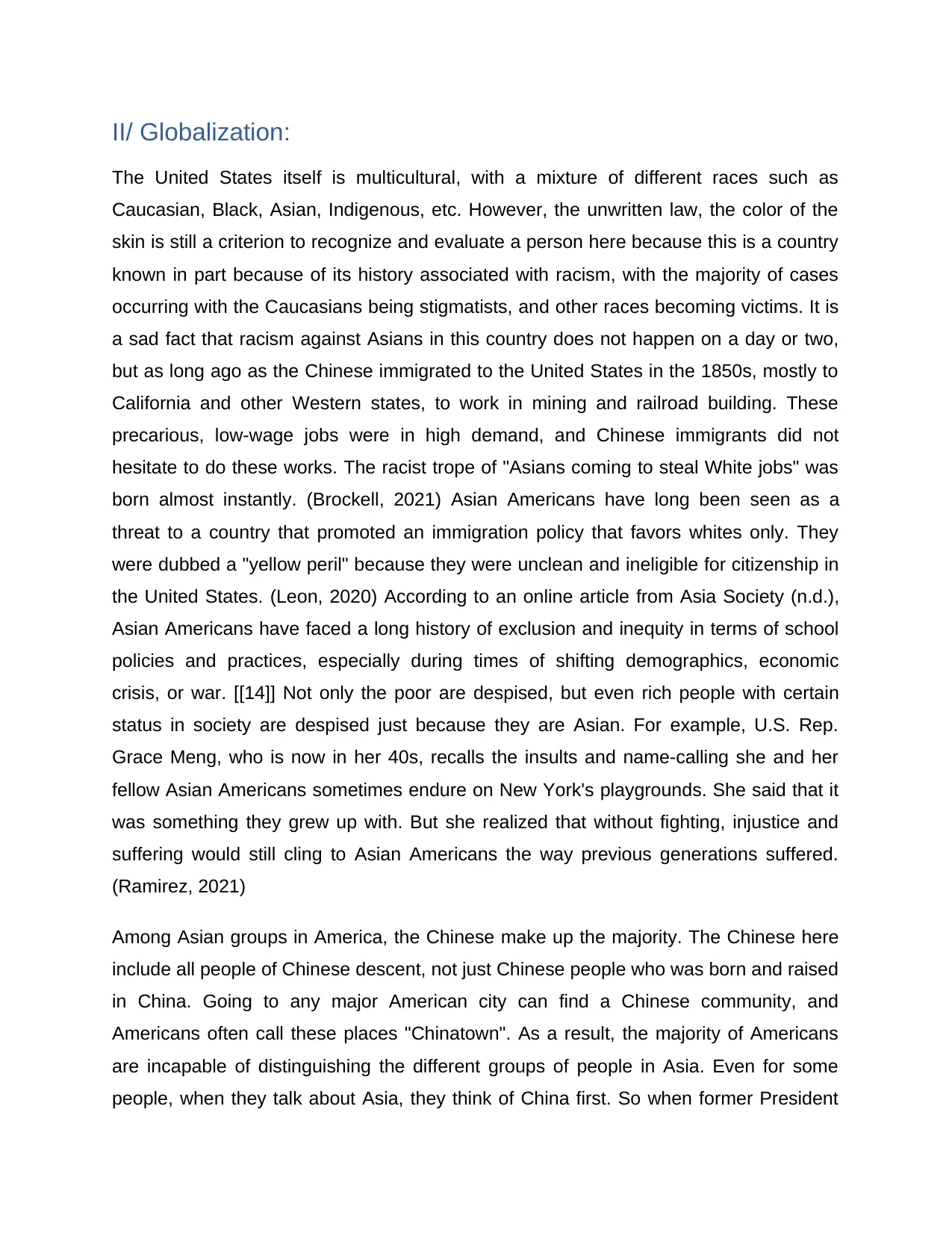
II/ Globalization:
The United States itself is multicultural, with a mixture of different races such as
Caucasian, Black, Asian, Indigenous, etc. However, the unwritten law, the color of the
skin is still a criterion to recognize and evaluate a person here because this is a country
known in part because of its history associated with racism, with the majority of cases
occurring with the Caucasians being stigmatists, and other races becoming victims. It is
a sad fact that racism against Asians in this country does not happen on a day or two,
but as long ago as the Chinese immigrated to the United States in the 1850s, mostly to
California and other Western states, to work in mining and railroad building. These
precarious, low-wage jobs were in high demand, and Chinese immigrants did not
hesitate to do these works. The racist trope of "Asians coming to steal White jobs" was
born almost instantly. (Brockell, 2021) Asian Americans have long been seen as a
threat to a country that promoted an immigration policy that favors whites only. They
were dubbed a "yellow peril" because they were unclean and ineligible for citizenship in
the United States. (Leon, 2020) According to an online article from Asia Society (n.d.),
Asian Americans have faced a long history of exclusion and inequity in terms of school
policies and practices, especially during times of shifting demographics, economic
crisis, or war. [[14]] Not only the poor are despised, but even rich people with certain
status in society are despised just because they are Asian. For example, U.S. Rep.
Grace Meng, who is now in her 40s, recalls the insults and name-calling she and her
fellow Asian Americans sometimes endure on New York's playgrounds. She said that it
was something they grew up with. But she realized that without fighting, injustice and
suffering would still cling to Asian Americans the way previous generations suffered.
(Ramirez, 2021)
Among Asian groups in America, the Chinese make up the majority. The Chinese here
include all people of Chinese descent, not just Chinese people who was born and raised
in China. Going to any major American city can find a Chinese community, and
Americans often call these places "Chinatown". As a result, the majority of Americans
are incapable of distinguishing the different groups of people in Asia. Even for some
people, when they talk about Asia, they think of China first. So when former President
The United States itself is multicultural, with a mixture of different races such as
Caucasian, Black, Asian, Indigenous, etc. However, the unwritten law, the color of the
skin is still a criterion to recognize and evaluate a person here because this is a country
known in part because of its history associated with racism, with the majority of cases
occurring with the Caucasians being stigmatists, and other races becoming victims. It is
a sad fact that racism against Asians in this country does not happen on a day or two,
but as long ago as the Chinese immigrated to the United States in the 1850s, mostly to
California and other Western states, to work in mining and railroad building. These
precarious, low-wage jobs were in high demand, and Chinese immigrants did not
hesitate to do these works. The racist trope of "Asians coming to steal White jobs" was
born almost instantly. (Brockell, 2021) Asian Americans have long been seen as a
threat to a country that promoted an immigration policy that favors whites only. They
were dubbed a "yellow peril" because they were unclean and ineligible for citizenship in
the United States. (Leon, 2020) According to an online article from Asia Society (n.d.),
Asian Americans have faced a long history of exclusion and inequity in terms of school
policies and practices, especially during times of shifting demographics, economic
crisis, or war. [[14]] Not only the poor are despised, but even rich people with certain
status in society are despised just because they are Asian. For example, U.S. Rep.
Grace Meng, who is now in her 40s, recalls the insults and name-calling she and her
fellow Asian Americans sometimes endure on New York's playgrounds. She said that it
was something they grew up with. But she realized that without fighting, injustice and
suffering would still cling to Asian Americans the way previous generations suffered.
(Ramirez, 2021)
Among Asian groups in America, the Chinese make up the majority. The Chinese here
include all people of Chinese descent, not just Chinese people who was born and raised
in China. Going to any major American city can find a Chinese community, and
Americans often call these places "Chinatown". As a result, the majority of Americans
are incapable of distinguishing the different groups of people in Asia. Even for some
people, when they talk about Asia, they think of China first. So when former President
Paraphrase This Document
Need a fresh take? Get an instant paraphrase of this document with our AI Paraphraser
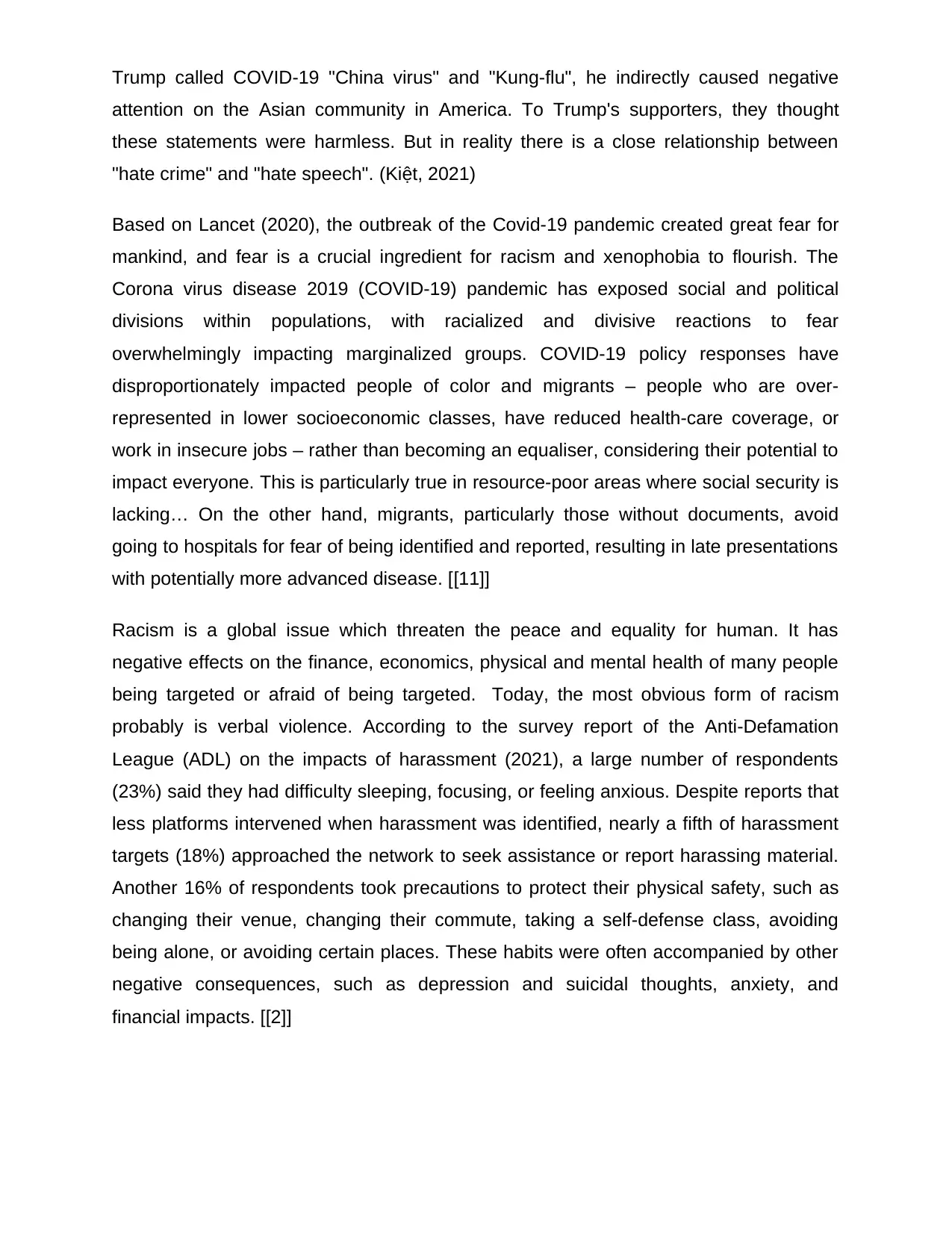
Trump called COVID-19 "China virus" and "Kung-flu", he indirectly caused negative
attention on the Asian community in America. To Trump's supporters, they thought
these statements were harmless. But in reality there is a close relationship between
"hate crime" and "hate speech". (Kiệt, 2021)
Based on Lancet (2020), the outbreak of the Covid-19 pandemic created great fear for
mankind, and fear is a crucial ingredient for racism and xenophobia to flourish. The
Corona virus disease 2019 (COVID-19) pandemic has exposed social and political
divisions within populations, with racialized and divisive reactions to fear
overwhelmingly impacting marginalized groups. COVID-19 policy responses have
disproportionately impacted people of color and migrants – people who are over-
represented in lower socioeconomic classes, have reduced health-care coverage, or
work in insecure jobs – rather than becoming an equaliser, considering their potential to
impact everyone. This is particularly true in resource-poor areas where social security is
lacking… On the other hand, migrants, particularly those without documents, avoid
going to hospitals for fear of being identified and reported, resulting in late presentations
with potentially more advanced disease. [[11]]
Racism is a global issue which threaten the peace and equality for human. It has
negative effects on the finance, economics, physical and mental health of many people
being targeted or afraid of being targeted. Today, the most obvious form of racism
probably is verbal violence. According to the survey report of the Anti-Defamation
League (ADL) on the impacts of harassment (2021), a large number of respondents
(23%) said they had difficulty sleeping, focusing, or feeling anxious. Despite reports that
less platforms intervened when harassment was identified, nearly a fifth of harassment
targets (18%) approached the network to seek assistance or report harassing material.
Another 16% of respondents took precautions to protect their physical safety, such as
changing their venue, changing their commute, taking a self-defense class, avoiding
being alone, or avoiding certain places. These habits were often accompanied by other
negative consequences, such as depression and suicidal thoughts, anxiety, and
financial impacts. [[2]]
attention on the Asian community in America. To Trump's supporters, they thought
these statements were harmless. But in reality there is a close relationship between
"hate crime" and "hate speech". (Kiệt, 2021)
Based on Lancet (2020), the outbreak of the Covid-19 pandemic created great fear for
mankind, and fear is a crucial ingredient for racism and xenophobia to flourish. The
Corona virus disease 2019 (COVID-19) pandemic has exposed social and political
divisions within populations, with racialized and divisive reactions to fear
overwhelmingly impacting marginalized groups. COVID-19 policy responses have
disproportionately impacted people of color and migrants – people who are over-
represented in lower socioeconomic classes, have reduced health-care coverage, or
work in insecure jobs – rather than becoming an equaliser, considering their potential to
impact everyone. This is particularly true in resource-poor areas where social security is
lacking… On the other hand, migrants, particularly those without documents, avoid
going to hospitals for fear of being identified and reported, resulting in late presentations
with potentially more advanced disease. [[11]]
Racism is a global issue which threaten the peace and equality for human. It has
negative effects on the finance, economics, physical and mental health of many people
being targeted or afraid of being targeted. Today, the most obvious form of racism
probably is verbal violence. According to the survey report of the Anti-Defamation
League (ADL) on the impacts of harassment (2021), a large number of respondents
(23%) said they had difficulty sleeping, focusing, or feeling anxious. Despite reports that
less platforms intervened when harassment was identified, nearly a fifth of harassment
targets (18%) approached the network to seek assistance or report harassing material.
Another 16% of respondents took precautions to protect their physical safety, such as
changing their venue, changing their commute, taking a self-defense class, avoiding
being alone, or avoiding certain places. These habits were often accompanied by other
negative consequences, such as depression and suicidal thoughts, anxiety, and
financial impacts. [[2]]
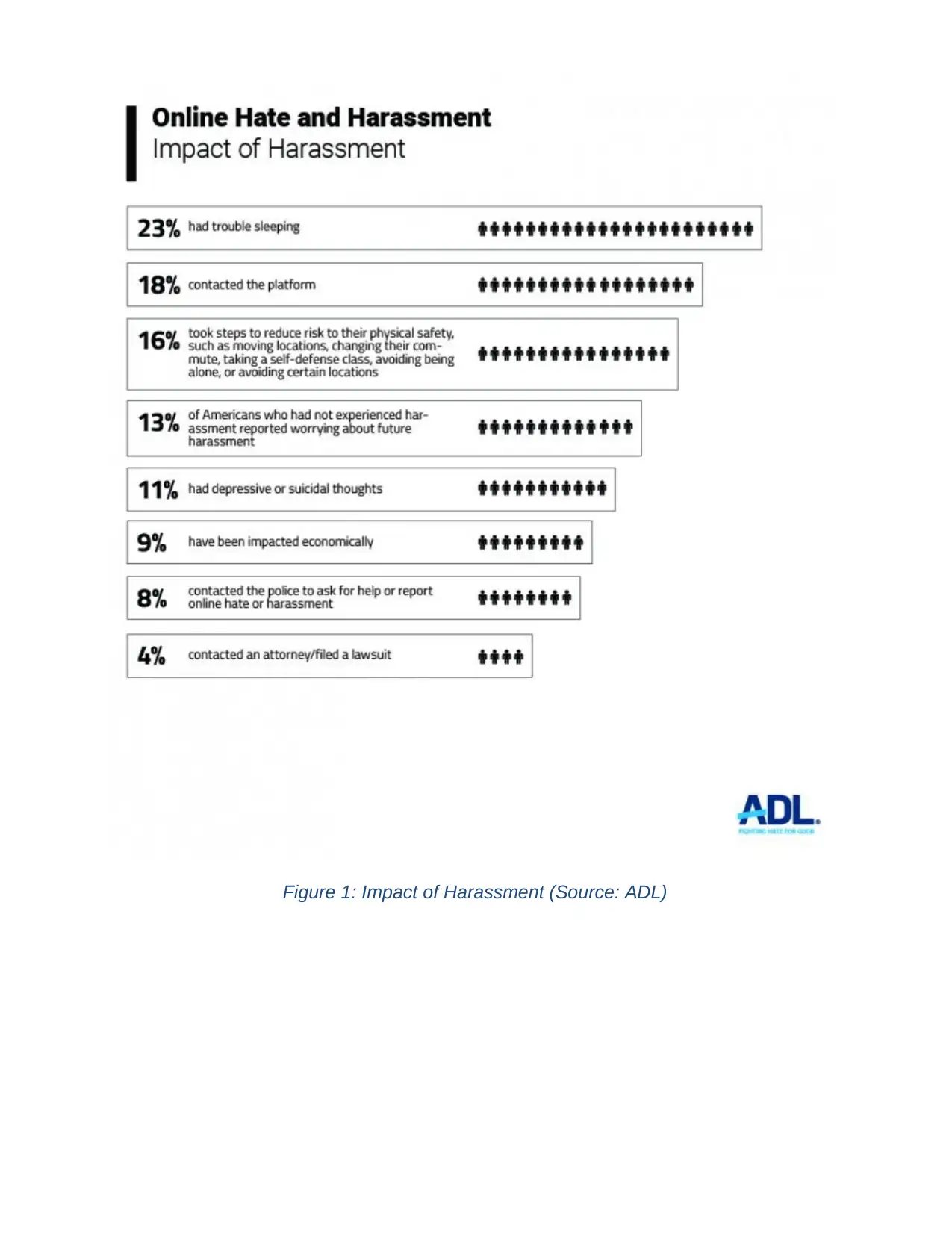
Figure 1: Impact of Harassment (Source: ADL)
⊘ This is a preview!⊘
Do you want full access?
Subscribe today to unlock all pages.

Trusted by 1+ million students worldwide
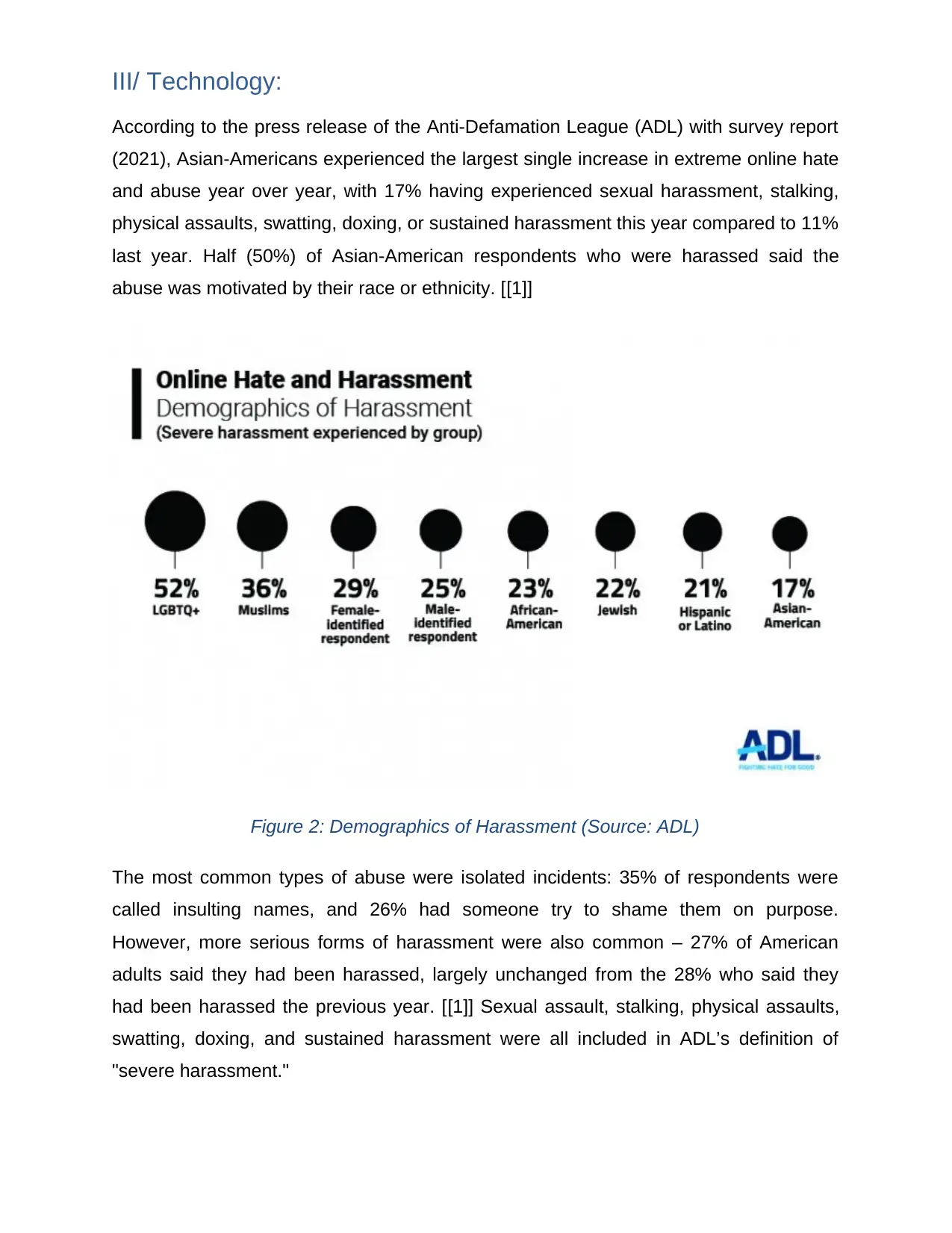
III/ Technology:
According to the press release of the Anti-Defamation League (ADL) with survey report
(2021), Asian-Americans experienced the largest single increase in extreme online hate
and abuse year over year, with 17% having experienced sexual harassment, stalking,
physical assaults, swatting, doxing, or sustained harassment this year compared to 11%
last year. Half (50%) of Asian-American respondents who were harassed said the
abuse was motivated by their race or ethnicity. [[1]]
Figure 2: Demographics of Harassment (Source: ADL)
The most common types of abuse were isolated incidents: 35% of respondents were
called insulting names, and 26% had someone try to shame them on purpose.
However, more serious forms of harassment were also common – 27% of American
adults said they had been harassed, largely unchanged from the 28% who said they
had been harassed the previous year. [[1]] Sexual assault, stalking, physical assaults,
swatting, doxing, and sustained harassment were all included in ADL’s definition of
"severe harassment."
According to the press release of the Anti-Defamation League (ADL) with survey report
(2021), Asian-Americans experienced the largest single increase in extreme online hate
and abuse year over year, with 17% having experienced sexual harassment, stalking,
physical assaults, swatting, doxing, or sustained harassment this year compared to 11%
last year. Half (50%) of Asian-American respondents who were harassed said the
abuse was motivated by their race or ethnicity. [[1]]
Figure 2: Demographics of Harassment (Source: ADL)
The most common types of abuse were isolated incidents: 35% of respondents were
called insulting names, and 26% had someone try to shame them on purpose.
However, more serious forms of harassment were also common – 27% of American
adults said they had been harassed, largely unchanged from the 28% who said they
had been harassed the previous year. [[1]] Sexual assault, stalking, physical assaults,
swatting, doxing, and sustained harassment were all included in ADL’s definition of
"severe harassment."
Paraphrase This Document
Need a fresh take? Get an instant paraphrase of this document with our AI Paraphraser
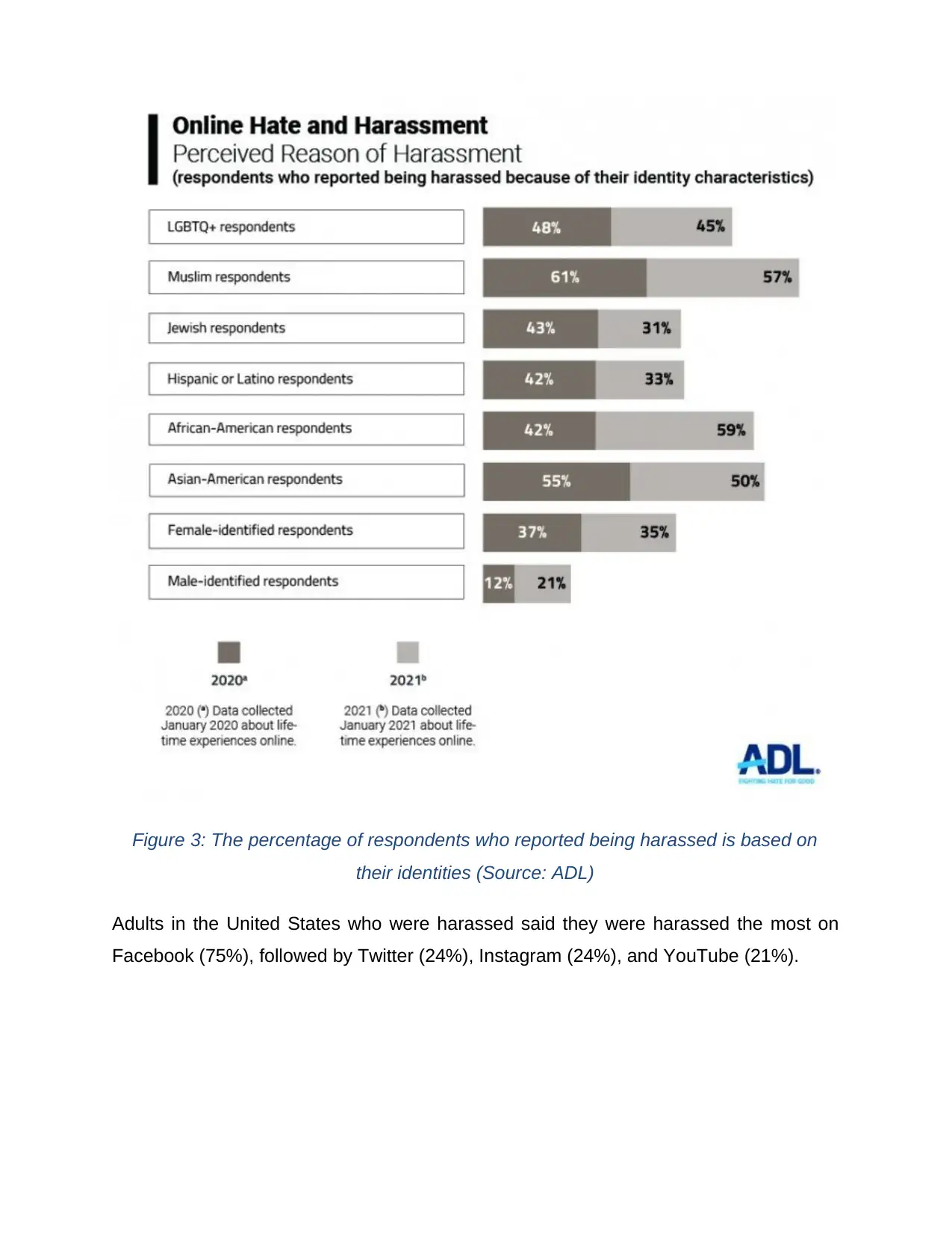
Figure 3: The percentage of respondents who reported being harassed is based on
their identities (Source: ADL)
Adults in the United States who were harassed said they were harassed the most on
Facebook (75%), followed by Twitter (24%), Instagram (24%), and YouTube (21%).
their identities (Source: ADL)
Adults in the United States who were harassed said they were harassed the most on
Facebook (75%), followed by Twitter (24%), Instagram (24%), and YouTube (21%).
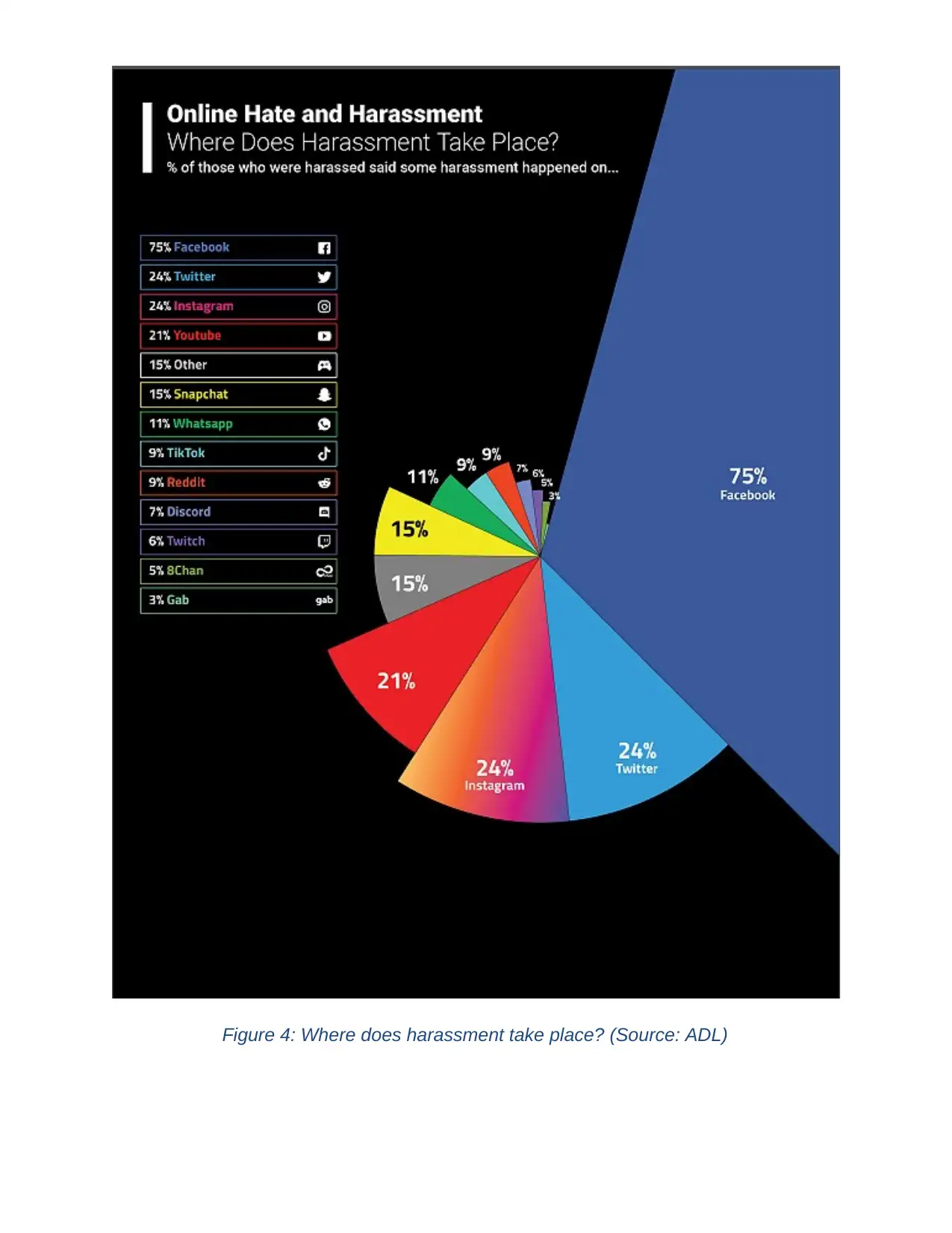
Figure 4: Where does harassment take place? (Source: ADL)
⊘ This is a preview!⊘
Do you want full access?
Subscribe today to unlock all pages.

Trusted by 1+ million students worldwide
1 out of 21
Your All-in-One AI-Powered Toolkit for Academic Success.
+13062052269
info@desklib.com
Available 24*7 on WhatsApp / Email
![[object Object]](/_next/static/media/star-bottom.7253800d.svg)
Unlock your academic potential
Copyright © 2020–2025 A2Z Services. All Rights Reserved. Developed and managed by ZUCOL.